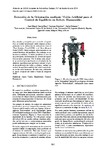Mostrar o rexistro simple do ítem
Detección de la orientación mediante visión artificial para el control de equilibrio en robots humanoides
| dc.contributor.author | García Haro, Juan Miguel | |
| dc.contributor.author | Martínez, Santiago | |
| dc.contributor.author | Balaguer, Carlos | |
| dc.date.accessioned | 2020-02-10T11:58:54Z | |
| dc.date.available | 2020-02-10T11:58:54Z | |
| dc.date.issued | 2018 | |
| dc.identifier.citation | García Haro, J.M., Martínez, S., Balaguer, C. Detección de la orientación mediante visión artificial para el control de equilibrio en robots humanoides. En Actas de las XXXIX Jornadas de Automática, Badajoz, 5-7 de Septiembre de 2018 (pp.951-957). DOI capítulo: https://doi.org/10.17979/spudc.9788497497565.0951 DOI libro: https://doi.org/10.17979/spudc.9788497497565 | es_ES |
| dc.identifier.isbn | 978-84-09-04460-3 (UEX) | |
| dc.identifier.isbn | 978-84-9749-756-5 (UDC electrónico) | |
| dc.identifier.uri | http://hdl.handle.net/2183/24872 | |
| dc.description.abstract | [Resumen] Los métodos principales para controlar el equilibrio de robots humanoides están basados principalmente en la utilización de indicadores como el \Foot Rotation Point"(FRI), o el \Zero Moment Point"(ZMP). Estos métodos están basados en un control dinámico del equilibrio. Sin embargo, en situaciones estáticas, la visión periférica es una de las principales herramientas de control del equilibrio en seres humanos. Por lo tanto, este proyecto se centrará principalmente en el estudio de los distintos algoritmos que permitan calcular el grado de inclinación del robot, y a futuro, realizar un control de equilibrio estático del robot inspirándose en los seres humanos. En este caso, utilizando la visión artificial del robot a través de imágenes RGB | es_ES |
| dc.description.abstract | [Abstract] The main methods to control the balance of humanoid robots are based on the use of indicators such as the Foot Rotation Point (FRI), or the Zero Moment Point (ZMP). These methods are based on a dynamic balance control. However, in static situations, peripheral vision is one of the main tools of balance control in human beings. Therefore, this project will focus mainly on the study of an algorithm that allows to calculate the estimated pose of the robot, and then, the performance of a bio-inspired static balance control of the robot. In this case, using the artificial vision of the robot through a kinect camera. | es_ES |
| dc.description.sponsorship | Ministerio de Economía y Competitividad; DPI2013-47944-C4-1-R | es_ES |
| dc.description.sponsorship | Comunidad de Madrid; S2013 / MIT-2748 | es_ES |
| dc.language.iso | spa | es_ES |
| dc.publisher | Área de Ingeniería de Sistemas y Automática, Universidad de Extremadura | es_ES |
| dc.relation.hasversion | http://hdl.handle.net/10662/8755 | |
| dc.relation.uri | https://doi.org/10.17979/spudc.9788497497565.0951 | es_ES |
| dc.rights | Atribución-NoComercial 3.0 España | es_ES |
| dc.rights.uri | http://creativecommons.org/licenses/by-nc/3.0/es/ | * |
| dc.subject | Visión | es_ES |
| dc.subject | Estabilidad | es_ES |
| dc.subject | Control | es_ES |
| dc.subject | Humanoide | es_ES |
| dc.subject | Vision | es_ES |
| dc.subject | Stability | es_ES |
| dc.subject | Control | es_ES |
| dc.subject | Humanoid | es_ES |
| dc.title | Detección de la orientación mediante visión artificial para el control de equilibrio en robots humanoides | es_ES |
| dc.title.alternative | Pose Estimation by Artificial Vision for Balance Control in Humanoid Robots | es_ES |
| dc.type | info:eu-repo/semantics/article | es_ES |
| dc.rights.access | info:eu-repo/semantics/openAccess | es_ES |
| UDC.startPage | 951 | es_ES |
| UDC.endPage | 957 | es_ES |
| dc.identifier.doi | https://doi.org/10.17979/spudc.9788497497565.0951 | |
| UDC.conferenceTitle | XXXIX Jornadas de Automática | es_ES |






